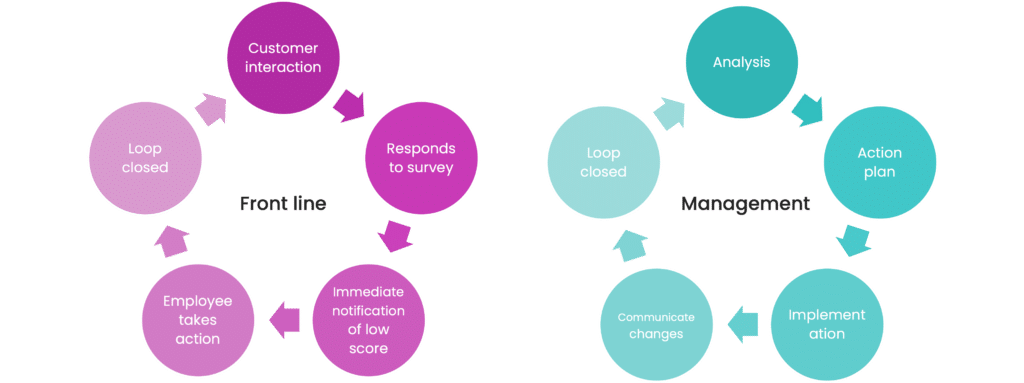Table of Contents
What is a closed feedback loop?
Closed loop feedback refers to when a company implements measures based on feedback from a customer. It involves direct or indirect follow-up on the customer’s concerns or praise to ensure a positive customer experience.
This kind of follow up is versatile and can be used it at different touch points along the customer journey. This also helps create a continuous flow of updates. It’s therefore important to keep collecting, analysing, and sharing the insights internally within the organisation. This way the organisation can continually improve on the back of customer feedback.
Table of contents
Why you should use a closed feedback loop
Several studies show that closing the feedback loop often leads to reduced customer churn, increased customer loyalty, and increased performance among employees. Furthermore, it can help to minimise the effort customers have to put into interacting with company.
A study from Gartner shows that 65% of those who had a negative experience with the customer service at a company spread negative publicity to others. Among those with a positive experience, only 25% spread positive publicity further. The studies illustrate how important it is to be fast, service-oriented, and proactive. These aspects help to avoid unnecessary negative word of mouth that can lead to customer churn and less new sales.
Research from Bain & Company shows: it generally costs a company six to seven times as much to acquire new customers as it does to retain existing ones. Marketing Metrics also completed a report showing that the probability of selling to an existing customer is generally 60-70%. In comparison, the probability of selling to new customers is only 5-20%. This demonstrates how important it is to retain existing customers.
Another example that show the importance of retaining customers is outlined in this HBR article. When Schwab founder Charles Schwab came out of retirement to take the company over, the business was struggling because it had lost the connection with their customers. He focused on direct customer feedback and closed loop systems:
The new customer feedback system has helped reestablish that connection. In 2008, the firm saw its revenues increase by 11% and the scores that customers gave the company jump by 25%.
Charles Schwab quoted in “Closing the customer feedback loop” (Hbr) by Rob Markey, Fred Reichheld, and Andreas Dullweber (2009).

Benefits of a closed feedback loop
Let’s have a closer look at some of the benefits that come with implementing a closed feedback loop.
Quick Resolution
Because your staff is able to immediately respond to any feedback received, you can resolve issues a lot quicker. This is important, because the efficiency of your customer service is one of the top reasons for customers to stay on with you or to jump ship! Closed loop feedback control offers your the immediacy that is necessary to keep your customers satisfied.
Increasing NPS
The Net Promoter Score (NPS) helps measure how likely your customers are to recommend you, whereby you can divide them into Promoters, Passives, and Detractors. The quick overturn of change on the basis of feedback and the quick resolution of issues will positively impact your NPS and might help you turn Detractors into Passives or Promoters!
Uncover Structural Problems
We all know that a good house starts with a good foundation. We might fin little cracks and try to repair them, but if we miss the bigger, structural problems, none of that is going to do any good. This is similar with improvements at your company. The closed loop feedback will help uncover not only individual issues experienced by customers, but by virtue of collecting data about the problems help you unearth possibly bigger, structural, operational problems. This could be a website that is not user-friendly at all, or the fact that staff are not trained well enough for their positions and might need up-skilling to deal with new challenges.
The addictive potential
Now, hear me out. Rather than a habit, something that plays on in the distance without anyone really bothering about it, closed loop feedback has the potential to hook your and your team, Fast Company explain: Because you make improvements on the basis of new information, you are even more eager to collect more information and get hooked. “As you exchange feedback with each of your team members, everyone takes it seriously, it gets easier, and feedback gets more accurate and more timely.”
Download: Your Guide to 3 key customer experience metrics (CSAT, NPS AND CES)
When to use this process
In general, you can use the closed feedback process at any point of contact with a customer. The main factor influencing when and how you can use closed feedback loops is quite simply your own internal resources. It takes time and effort to conduct follow-ups and run a closed loop system effectively.
One recommendation is to start small. Implement feedback loops in specific parts of the company to gain experience over time. This will help to create a larger and more comprehensive overall feedback loop. As a result, you improve processes internally and open up the process to essential contact points in the organisation.

How to design a closed feedback loop
The closed loop feedback process starts with finding relevant contact points along the customer journey, at which you want to focus on good customer experiences.
As a next step, you should design relevant questions with the aim of uncovering what creates dissatisfied customers. This is necessary so that one can address the challenges the moment they arise. For example, it could be in the form of an SMS after a call with customer service, a pop-up with a survey after a product purchase online, or asking for a short feedback on a service you have received.
When it comes to what questions to ask, studies show that one of the strongest drivers of disloyalty is the effort customer have to put into interacting with your company. This could mean they had to call customer service several times before an issue could be resolved, for instance. In other words, it is desirable for you to minimise the effort customers have to put into every touchpoint with your business.
This is where we speak of the Customer Effort Score (CES). The Customer Effort Score is a reliable and easy metric to use. The method measures exactly what is detailed above: the amount of effort costumers have to put in to achieve their goals with your business.
This links closely to integrating your closed feedback loop into your overall Customer Experience (CX) feedback strategy. You can use the same customer survey software, for instance, or make sure you can easily exchange data between the two. Then there are two major components for a successful closed loop:
A ticketing system
This is a sort of alarm system that alerts you to problems or negative feedback. You can set the thresholds here for what negative feedback is, i.e. through certain NPS scores etc. Ideally, your ticketing system is also linked to individual dashboards for the different departments so that the problem is immediately visible for the responsible department and they can work on it. If integrated correctly with your CX solution, these alarms should be automated.
The alerts also help to monitor the stats of overall complaints. For instance, if a certain demographic is consistently complaining about the same issue, this gives you insights into the root of the problem and subsequently how to tackle it. This is what we have mentioned before in the benefits section.
A case management system
In addition you need a case management system. This means that you can follow each ticket through the entire process until it is resolved. Thus you can make sure it is assigned to the right team and a resolution is achieved. Part of the monitoring process is also to see how you are dealing with your own targets. You may want to achieve to solve 80 % of complaints within the first 24h, for instance.
The strongest feedback loops do more than just connect customers, the front line, and a few decision makers in management, however; they keep the customer front and center across the entire organization.
“Closing the customer feedback loop” (Hbr) by Rob Markey, Fred Reichheld, and Andreas Dullweber (2009).
That’s why Markey, Reichheld, and Dullweber recommend using the NPS metric as a measurement for your closed loop feedback control. The NPS, as we mentioned earlier, groups customers as Promoters, Passives, Detractors. This provides a good general overview of your customer loyalty and satisfaction. Thereby it helps to see where targeted action needs to be taken.
As an example, let’s look at how Allianz uses NPS as a main metric for their closed loop feedback process:
“After every transaction, an independent polling firm immediately contacts the customer and conducts a brief survey. It e-mails the results immediately to the employee who provided the service and publishes aggregated results on local intranet “dashboards” for everyone to review. Frontline employees then follow up by calling a sample of customers who’ve agreed to be contacted. After listening to the issues customers raise, they correct the problems or escalate them to someone who can.” (HBR)
Including employees in the feedback loop
The feedback loop, however, shouldn’t be limited to your employees escalating problems or feedback to their managers. It should also be about giving your employees the opportunity to voice their own experiences, concerns, and problems. This way you can create a better work environment for them, which will in the end benefit the entire company. Especially in times of isolation and remote work, actively requesting feedback is especially important. Giving your employees the room to have their voices heard so that they feel included and acknowledged is incredibly valuable.
Try Netigate free for 30 days. Send your first survey in minutes.
Things to consider when closing the loop
A closed feedback loop is only one of many good methods, but is a comprehensive, essential tool since it is simple, versatile, and can give your business a lot of value. On the other hand, it only measures specific contact points in the customer journey and cannot help with an overall picture of the business in the same way as an annual customer survey can.
Therefore, we recommend always having a good interplay of different measurements to take the most advantage of the insight and feedback you get from your customers. This means integrating several methods like puzzle pieces into a larger feedback system that works specifically for your needs.
Furthermore, closed loop feedback will only be a success if you implement the changes based on the data you collect— and then evaluate if positive change actually occurs. This is where the interplay of measures comes in— for instance, evaluating progress with smaller pulse surveys.
Do you want to get started with your customer survey journey? At Netigate, we help our customers understand and improve their customers’ experiences with smart solutions. Contact us today and we will tell you more!
-
Helena Bjorkman
-
Helena Bjorkman
- 8 min read
- .







 Copyright © 2025 Netigate AB, Drottninggatan 25, 111 51, Stockholm, Sverige
Copyright © 2025 Netigate AB, Drottninggatan 25, 111 51, Stockholm, Sverige